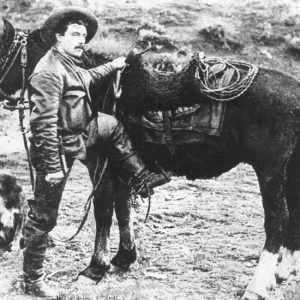calsfoundation@cals.org
USS Charles J. Finger
The USS Charles J. Finger, named for Fayetteville (Washington County) writer and editor Charles Joseph Finger, was a World War II Liberty Ship that saw wartime service in the Atlantic, Caribbean, and Pacific. After the war, the vessel sailed under the flags of four foreign nations prior to being scrapped in 1970.
In the early days of World War II, German U-boat attacks devastated British shipping, and American industry responded to the heavy losses of cargo ships by developing what became known as Liberty Ships. These mass-produced vessels contained 250,000 parts that were created in factories across the United States, then sent to several American shipyards for assembly into two sections, each about 220 feet long, that were then welded together.
The resulting 14,250-ton cargo ships were fifty-six feet, eleven inches wide and 441 feet, six inches long, costing about $2 million each. They could travel 11,000 miles, using three-cylinder engines that could produce 2,500 horsepower and make up to eleven knots. The ships could carry more than 9,000 tons of cargo, with other freight tied down to the deck.
The Liberty Ships had crews of about forty-four merchant marines and from twelve to twenty-five Naval Armed Guards who would operate the vessel’s armaments, which could consist of a three-inch bow gun, four- or five-inch stern guns, a pair of 37 mm bow guns, and six 20 mm machine guns. The first of 2,711 Liberty Ships constructed over the course of the war was launched on September 27, 1941; around 200 of them would be lost to enemy attacks.
The Liberty Ships were christened with the names of prominent deceased Americans, and the vessel that would receive hull number 2909 was named for Charles J. Finger, an adventurer, author, and editor who died in Fayetteville on January 7, 1941. The vessel’s hull was laid at the Todd Houston Shipbuilding Corporation’s shipyard at Houston, Texas, on December 8, 1943. Liberty Ships were known for being constructed quickly, and the USS Charles J. Finger was no different, being completed in only sixty-three days. The vessel was launched on January 28, 1944, and delivered on February 8.
The Finger undertook a shakedown cruise, or test run, from Galveston, Texas, to Key West, Florida, before joining a convoy to New York, arriving there on February 28. It was one of ninety-nine cargo vessels and twenty escort ships in a convoy that left New York on March 6 and arrived at Liverpool, England, on March 22. Returning to New York on April 24, the ship made quick turnaround and arrived back in England on June 2, 1944. It left Liverpool on June 10 and arrived back in New York on June 28, left there on July 11, and arrived in Scotland on July 23. After two months of service in United Kingdom waters, the USS Charles J. Finger left Liverpool on September 13, hitting New York on September 28 at the end of its final transatlantic run.
The Finger sailed to Caribbean waters on October 18, 1944, and worked ports there and along South America’s Pacific coast until December 8 or 9, ending that deployment at Pensacola, Florida, on December 15. The vessel sailed to the Panama Canal on January 11, 1945, and returned to the Pacific Ocean, arriving in New Guinea on February 12, this time without a convoy. After a lengthy stay at Manus Island, the Finger left with a U.S. Navy escort on April 1, arriving at Ulithi five days later. Leaving there on May 26, the ship sailed unescorted to the Philippines and worked in those waters until July 14, when it returned to the United States, arriving at San Francisco on August 10. The war ended with the August 14, 1945, surrender of Japan, and the USS Charles J. Finger was sent to anchor in the James River, arriving there on October 20, 1945, ending its career in service to the United States after twenty-two months and 45,000 nautical miles.
The U.S. government sold the Finger to the East Asiatic Line out of Denmark in 1947, which renamed the ship the St. Thomas; the vessel became the Cavostaras after being sold to Aragon Cia. Nav. to sail under a Panamanian flag in 1951. Another Panamanian company acquired the ship in 1953, naming it first the Despina, then in 1959 the Amfithea, the name with which the vessel steamed under a Greek flag. In 1964, the erstwhile USS Charles J. Finger was transferred to Chowgule Steamships and dubbed the Maratha Explorer, now sporting an Indian flag, which it still flew under when it was renamed the Samudra Vijay by new owners Pent-Ocean Steamships of Bombay in 1966. The freighter was scrapped at Bombay in 1970.
For additional information:
Leflar, Charles Joseph Finger. The USS Charles J. Finger (Fayetteville: 2011). Special Collections. University of Arkansas Libraries, Fayetteville, Arkansas.
Mark K. Christ
Central Arkansas Library System
 Military
Military World War II through the Faubus Era, 1941 through 1967
World War II through the Faubus Era, 1941 through 1967 Charles Finger
Charles Finger 



Comments
No comments on this entry yet.